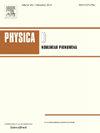从超图到简单复合体的相位缩减理论:通往高阶Kuramoto模型的一般途径
IF 2.9
3区 数学
Q1 MATHEMATICS, APPLIED
引用次数: 0
摘要
仓本模型是耦合振子研究中的典范模型,因为它提供了集体同步跃迁的简单解释。它们的普适性来自于它们是通过相还原得到的。最近的证据强调了高阶(多体)相互作用在描述现实世界系统中的重要性,这导致了kuramoto型模型的扩展,以包括这样的框架。然而,这些扩展大多是通过增加高阶项而不是进行系统的相位缩减来获得的,这就留下了在相位模型中自然出现高阶耦合的问题。在本文中,我们通过提出超图上耦合振子的相位缩减理论来填补这一空白,即高阶相互作用的最一般情况。我们发现,虽然在相位约简模型中保留了高阶连接拓扑,但由于超图在约简kuramoto型模型中通常变成简单复合体,因此交互拓扑通常会发生变化。此外,我们证明,当振子具有一定的对称性时,即使耦合对于一阶动力学是无关的。通过将相位缩减方法应用于具有全对全构形和环状超图拓扑的Stuart-Landau振子群,说明了相位缩减方法的有效性和延展性;在这两种情况下,阶段模型的分析可以提供更深入的见解和分析结果。本文章由计算机程序翻译,如有差异,请以英文原文为准。
Theory of phase reduction from hypergraphs to simplicial complexes: A general route to higher-order Kuramoto models
Kuramoto-type models are paradigmatic models in the study of coupled oscillators, since they provide a simple explanation of the collective synchronization transition. Their universality comes from the fact that they are derived through phase reduction. Recent evidence highlighting the importance of higher-order (many-body) interactions in the description of real-world systems has led to extensions of Kuramoto-type models to include such frameworks. However, most of these extensions were obtained by adding higher-order terms instead of performing systematic phase reduction, leaving the questions of which higher-order couplings naturally emerge in the phase model. In this paper, we fill this gap by presenting a theory of phase reduction for coupled oscillators on hypergraphs, i.e., the most general case of higher-order interactions. We show that, although higher-order connection topology is preserved in the phase reduced model, the interaction topology generally changes, due to the fact that the hypergraph generally turns into a simplicial complex in the reduced Kuramoto-type model. Furthermore, we show that, when the oscillators have certain symmetries, even couplings are irrelevant for the dynamics at the first order. The power and ductility of the phase reduction approach are illustrated by applying it to a population of Stuart–Landau oscillators with an all-to-all configuration and with a ring-like hypergraph topology; in both cases, the analysis of the phase model can provide deeper insights and analytical results.
求助全文
通过发布文献求助,成功后即可免费获取论文全文。
去求助
来源期刊

Physica D: Nonlinear Phenomena
物理-物理:数学物理
CiteScore
7.30
自引率
7.50%
发文量
213
审稿时长
65 days
期刊介绍:
Physica D (Nonlinear Phenomena) publishes research and review articles reporting on experimental and theoretical works, techniques and ideas that advance the understanding of nonlinear phenomena. Topics encompass wave motion in physical, chemical and biological systems; physical or biological phenomena governed by nonlinear field equations, including hydrodynamics and turbulence; pattern formation and cooperative phenomena; instability, bifurcations, chaos, and space-time disorder; integrable/Hamiltonian systems; asymptotic analysis and, more generally, mathematical methods for nonlinear systems.
 求助内容:
求助内容: 应助结果提醒方式:
应助结果提醒方式:


